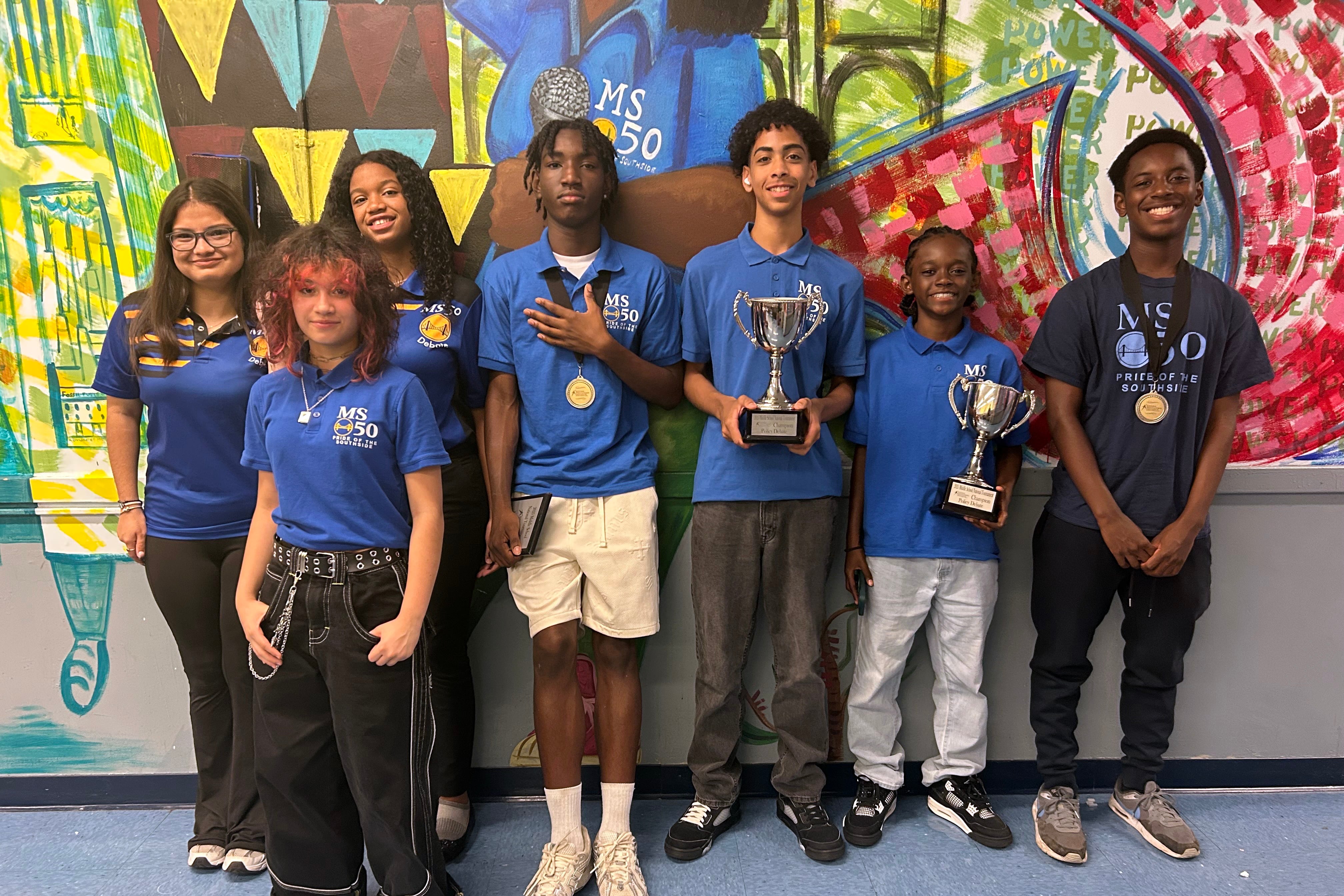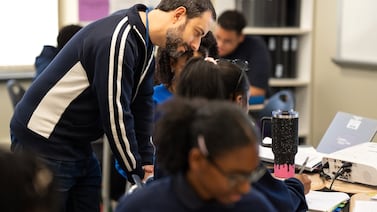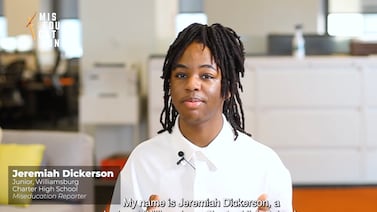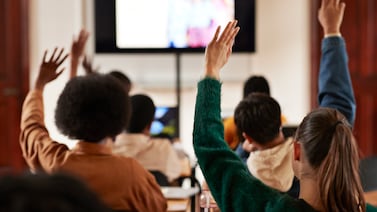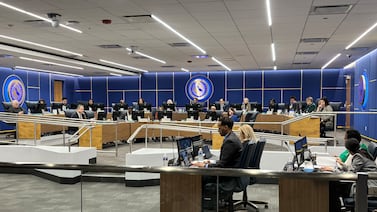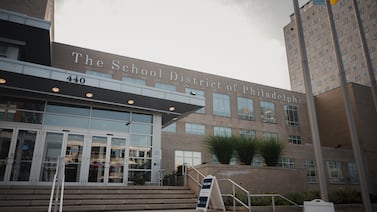Sign up for Chalkbeat New York’s free daily newsletter to get essential news about NYC’s public schools delivered to your inbox.
Standing on stage in Des Moines, Iowa, in June at the awards ceremony for the nation’s largest middle school debate tournament, 14-year-old Erick Williams was shocked to hear the announcement coming from the podium.
He turned to his partner, Anedwin Moran, to make sure he hadn’t heard wrong. The two eighth graders from M.S. 50 in Williamsburg, Brooklyn, were national champions.
It was the capstone of a remarkable debate journey for Williams, Moran, and M.S. 50, which has a student poverty rate of nearly 90% and a decade ago was on the list of the most troubled schools in the city and at risk of closure. Since then, Principal Ben Honoroff has embraced debate as a way to transform the school’s academic outcomes and reputation. M.S. 50’s debate program has captured multiple citywide titles, inspired local elementary schools in the area to launch their own programs, and brought the first-ever Spanish language debaters to the National Speech and Debate Association’s annual tournament.
But a title at the nation’s most prestigious middle school debate tournament had eluded M.S. 50 — until this year.
For Honoroff, it was validation not just of the hard work and talent of the kids and staff but also of the unique way the school approaches debate.
“It’s a victory for the way we are interpreting policy debate: as a way of having kids be critical about the resolution and invoke their own lived experience,” he said.
In the world of competitive policy debate, students spend long hours outside school poring through dense academic material to craft arguments they often try to cram into tight time limits by speed-talking. The format has historically favored private and affluent public schools with the resources to hire multiple coaches and send students to tutors and debate camps, said Honoroff, a longtime coach.
At M.S. 50, staffers believe students make the best arguments when they believe what they’re saying — and when it draws on their life experience.
“While we might be way behind our competitors in terms of resources … what we have more than them often is lived experiences around issues of equity and justice,” Honoroff said. “When we can teach our kids to leverage that, then they become really powerful debaters.”
That was on display at this year’s competition, where teams had to make a case for or against the resolution that the federal government should increase intellectual property protections. M.S. 50 decided to center its argument on graffiti, a subject many of the students knew first-hand living in neighborhoods like Bushwick, Bedford-Stuyvesant, and Williamsburg.
They argued that local graffiti artists, who, like the M.S. 50 students, are mostly Black and Latino, are often unfairly targeted by law enforcement, even while their more famous counterparts, like the artist “Banksy,” are celebrated and their work can increase property values in gentrifying areas.
For eighth grader Coco Suzuki, it was an easy argument to make. She personally knows graffiti artists who “have suffered from their art.”
“If it [the argument] has a connection to your life,” said Pryce Sanders, another member of the debate team, “everything just flows better.”
Debate helps a school turn the page
At M.S. 50, debate is woven into almost every aspect of the school.
Every teacher gets training about how to bring “evidence-based argumentation” into their classes. On top of that, about 120 of the school’s nearly 400 students, roughly a third, enroll in a designated debate elective, where they get a mix of reading support and practice debating in public — along with the chance to compete in local tournaments. A select group of eight students meets outside of school and travels to tournaments across the country.
Honoroff credits the focus on debate with helping boost the school’s academic achievement and shoring up declining enrollment, which dipped to a low of under 200 students in 2015.
“If they’re in debate, they’re working on their reading, their writing, their speaking, their listening, their teamwork, their activism,” he said. “We know that they’ll be reading more on one Saturday at a debate tournament than they probably read the whole week.”
The activity can be especially beneficial for students who are behind grade level in reading or who are still learning English, a group that makes up about 16% of the school, Honoroff said.
But he knew English language learners were still at a massive disadvantage in competitive tournaments. That’s why M.S. 50 pushed for permission to allow some debaters to compete in Spanish at the national debate tournament — the first time that had happened in the tournament’s nearly 100-year history. M.S. 50 pays for its own interpreters, who translate both the oral arguments and written documents between Spanish and English.
This year, two of the eight members of M.S. 50’s national debate tournament team were Spanish-speaking immigrants who arrived in the country last school year. One of them, Arceny Reynoso, who came from the Dominican Republic, won a speaking award.
“I didn’t expect this prize,” she said in Spanish. At first, she suffered debilitating tremors and shivers when she got up to speak. But this year, judges were impressed by her confidence and forcefulness, said her partner, Briana Paz.
As M.S. 50’s debate program has grown in size and stature, the effects have rippled outward.
Several elementary schools in the area have now launched their own debate programs. Students like Williams and Sanders have been debating since they were in third grade and sought out M.S. 50 specifically for its debate program.
Overcoming obstacles to claim a top prize
For M.S. 50, competing on the national stage has meant directly confronting some of the inequities they highlight in their arguments.
Despite some recent progress in diversifying the ranks of the national debate competition, M.S. 50 students said they still were often among the only Black or Latino students in a given room. The students were also acutely aware of coming from a high-poverty urban school — often having to explain concepts that weren’t familiar to debaters from other backgrounds.
“We have arguments that relate to some of the struggles that people in New York, which is a very diverse place, would struggle with,” said Suzuki. “Having to explain that” to teams from more homogenous places “was a bit heavy.”
At times, M.S. 50 students noticed disapproving glances from other teams when they opted for more comfortable attire over formal wear. Some teams also raised objections to the Spanish-language debaters, arguing the format gives M.S. 50 an unfair advantage. And their opponents have sometimes made arguments that disturbed the M.S. 50 students — like when a team referred to undocumented immigrants as “illegals” and when another argued that colonization had helped the world.
For M.S. 50 debate coach Miana Vega, a paraprofessional and former nationally competitive policy debater, helping her students navigate those difficult moments is just as important a part of the job as helping them polish their arguments.
“For me, specifically, that’s why I do what I do,” Vega said. “Policy debate prepares students to deal with real-life situations, realities that are often difficult to talk about.”
To help the students process the feelings that come up in those moments, Vega encourages them to write poetry. And it’s that kind of learning, more than any of the awards, that Vega and Honoroff say they’re proudest of.
“The reason that we do debate is not because of those victories and those trophies,” Honorff said. “It is to teach our students to learn how to use their voices to be leaders for peace and justice in the world.”
Michael Elsen-Rooney is a reporter for Chalkbeat New York, covering NYC public schools. Contact Michael at melsen-rooney@chalkbeat.org

